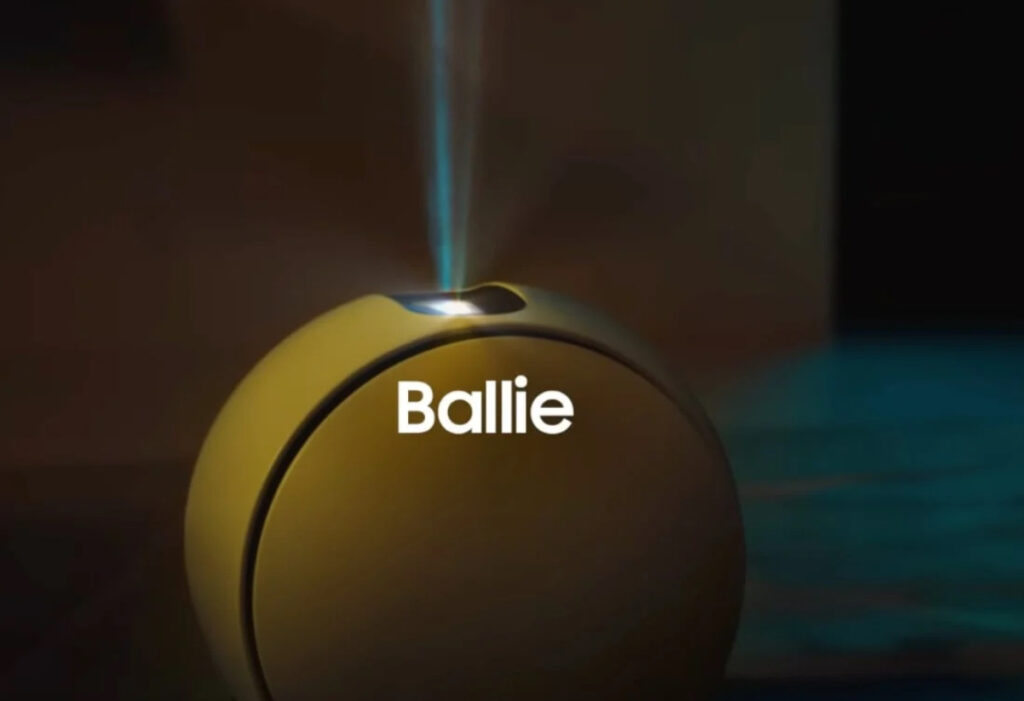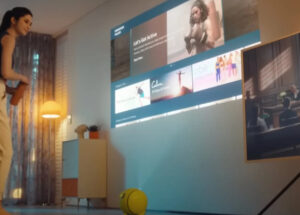

It’s official: Ballie is no longer just a prototype. After half a decade of development and countless demo videos, Samsung’s robotic sphere is rolling out of the lab and into living rooms in the U.S. and South Korea this summer. First teased at CES 2020 as a compact tennis ball-sized home assistant, Ballie has since grown in size, capability, and ambition—and it’s poised to be one of the most intriguing smart home releases of the decade.
Now roughly the size of a volleyball and equipped with advanced on-device AI, ambient computing capabilities, and Google Cloud’s Gemini AI integration, Ballie is Samsung’s boldest leap into personal robotics to date. It’s no longer just about controlling lights or playing your favorite playlist. Ballie is about companionship, routine management, and intelligent interaction, all wrapped in a rolling orb with glowing eyes.
Here’s what you need to know about the launch, what’s changed since 2020, and why Samsung is betting big on a robot that follows you around the house.
The Ballie Journey: From CES Showstopper to Smart Home Star
Ballie first captured imaginations at CES 2020 with a brief, adorable video. In it, the small robot followed its owner around, responded to voice commands, opened curtains, turned on the TV, and even interacted with a dog. It was equal parts Wall-E and BB-8, with a touch of futuristic smart assistant.
The problem? It was a concept, not a consumer-ready product. And for five years, Ballie lived in that ambiguous zone between vaporware and visionary—occasionally re-emerging at tech shows, each time slightly more capable, but never quite ready for prime time.
That’s changed in 2025. Samsung has confirmed that Ballie will be available for purchase in July, with a retail price rumored to be around $1,600 USD, though exact regional pricing has not yet been finalized.
So What Does the 2025 Ballie Actually Do?
This year’s version of Ballie is no longer just a glorified smart speaker on wheels. It’s a multi-sensory, AI-enhanced home companion. Let’s break down its most notable features:
AI-Powered Awareness
Ballie now features dual cameras with depth sensors and a 360-degree microphone array. This allows it to recognize people, pets, objects, and environmental changes. It uses this data to build a spatial map of your home—learning where furniture is, identifying rooms by use, and anticipating patterns like your morning routine or nightly wind-down.
Google Cloud x Gemini Integration
Perhaps the most exciting upgrade is Ballie’s native integration with Google’s Gemini AI, which powers natural conversations, context memory, and cross-platform connectivity. With this feature, Ballie can:
- Respond to complex questions (“What’s on my calendar after 4 p.m. and will it rain then?”)
- Integrate with Google Workspace, Gmail, and smart home platforms
- Offer conversational summaries of news, emails, or texts
- Translate live conversations in multilingual households
- Learn user preferences over time using on-device AI and cloud syncing
Projector + Entertainment Mode
Ballie includes a built-in short-throw projector, allowing it to display visuals on walls or tables. Whether projecting yoga instructions during a morning workout, streaming cartoons for kids, or acting as a visual intercom for video messages, this feature adds a surprising level of functionality. The projector includes ambient brightness adjustment and an auto-keystone feature for clear, crisp visuals from any angle.
Pet and Child Interaction
Samsung has refined Ballie’s ability to recognize and engage with pets and young children. It can:
- Play preloaded pet videos or music
- Send owners clips of unusual pet behavior
- Alert parents when a child enters a restricted room
- Engage toddlers with projections, sounds, and mobility games
Home Automation Hub
Ballie connects to SmartThings, Samsung’s smart home platform. It can control lighting, blinds, HVAC, appliances, and security systems. More impressively, it automates based on context rather than just commands. If you fall asleep on the couch, Ballie might dim the lights and lower the temperature. If it notices movement by the door when no one’s supposed to be home, it can alert you via your phone.
The Physical Redesign: Form Meets Functionality
While early versions of Ballie were palm-sized and adorable, the production model is larger, sturdier, and far more expressive. The decision to scale up came from both technical and usability needs—larger wheels mean better mobility over rugs, thresholds, and tile changes. A bigger chassis allows more powerful processors, battery modules, and a richer speaker system.
Ballie now sports:
- LED “eyes” that blink and animate with mood
- A rubberized polycarbonate shell for durability and grip
- Soft-close compartment flaps for charging or micro-cargo tasks (like delivering a note)
- USB-C charging dock with inductive coupling
- Interchangeable color sleeves—launching in pastel blue, matte graphite, and cream white
And yes—Ballie now climbs small ramps and transitions between surfaces without getting stuck, a major issue during early prototype trials.
Use Case Spotlight: A Day in the Life with Ballie
Samsung envisions Ballie as a living assistant that becomes part of your household rhythm. Here’s what a day with Ballie might look like:
7:00 a.m. — Ballie wakes you by opening your blinds and playing your favorite morning playlist. It gently nudges the foot of your bed with a soft chime if you ignore your alarm.
7:30 a.m. — While you brush your teeth, Ballie projects a short weather and traffic summary on your bathroom wall.
8:15 a.m. — As you prep coffee, Ballie reads back your first three calendar events and suggests moving your 1 p.m. call to accommodate an incoming thunderstorm.
1:30 p.m. — You receive a notification that Ballie detected your dog pacing anxiously near the front door. It sends a 20-second clip to your phone.
6:00 p.m. — Ballie dims the kitchen lights as it detects you preparing dinner and queues up your “Cooking” Spotify playlist.
9:45 p.m. — You’re winding down. Ballie projects a sleep meditation video onto your bedroom wall and begins its night-time routine sweep: lights off, doors locked, temperature down.
It’s not just a novelty. It’s a presence.
The Human-Robot Relationship Question
While Ballie doesn’t speak with a voice (to avoid crossing into “creepy” territory), its animated LED expressions and tonal cues form a language of their own. It communicates in beeps, whirs, light pulses, and movement—a design decision made to encourage emotional bonding without anthropomorphism.
Samsung has conducted multiple studies in elder care and pediatric environments that suggest users form “nonverbal companionship patterns” with robots like Ballie. Think: a presence that reminds you, supports you, and recognizes you, but doesn’t pretend to be human.
It’s a subtle evolution of the smart assistant genre—less like Siri or Alexa, more like a helpful house pet with a photographic memory.
Privacy and Data Concerns
Given Ballie’s camera system and continuous monitoring features, privacy is a valid concern. Samsung has emphasized the following safeguards:
- On-device processing for all visual data, with cloud syncing optional
- Encrypted local storage, automatically wiped every 24 hours unless manually saved
- Physical camera shutter, controllable via command or companion app
- Consent-based facial recognition—only people registered in the companion app are tracked or responded to by name
Samsung’s partnership with Google Cloud includes strict usage limitations for Gemini AI, and no data is sold to advertisers or third-party partners, according to the company.
Market Position and Price Strategy
Priced at a rumored $1,600 USD, Ballie enters a new consumer category somewhere between robot vacuum and personal assistant. It’s more emotionally engaging than a Roomba, more physically mobile than a smart display, and more multifunctional than a Nest Hub.
Samsung knows Ballie will appeal first to early adopters, tech enthusiasts, and premium smart home users, with broader appeal likely to follow through future software updates and scaled-down models.
Competitors are watching closely. LG’s CLOi platform, Amazon’s Astro, and various indie robotics firms are all moving into this space—but Ballie might just have the head start it needs.
Impression
Five years in the making, Ballie’s consumer release is more than just a gadget launch—it’s a bellwether for where personal robotics might finally be headed. With AI at its core, a tangible body in motion, and a clear use case in everyday routines, Ballie embodies what many smart home devices have lacked: personality, autonomy, and integrated purpose.
It doesn’t just sit and wait for a command. It moves. It sees. It acts.
No comments yet.








